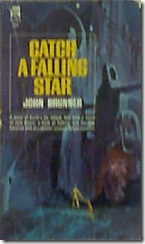 I used Brunner’s Shockwave Rider as required reading in a course I taught in Artificial Intelligence. In 1975 Brunner was able to predict the WWW, if not in specific details, in attitude. The book describes a world wide interactive information network. He was the first person to describe a "worm" or self replicating computer program that is able become part of the network and change its behavior.
I used Brunner’s Shockwave Rider as required reading in a course I taught in Artificial Intelligence. In 1975 Brunner was able to predict the WWW, if not in specific details, in attitude. The book describes a world wide interactive information network. He was the first person to describe a "worm" or self replicating computer program that is able become part of the network and change its behavior.
15 to 20 years before writing Shockwave Rider, Brunner was producing a large number of books and short stories. He always was prolific and wrote sometimes four books a year. Many of these were short novels, about 60,000 words or less, that appeared in Ace Doubles. I collect Ace Doubles and I must have 20 Brunner titles.
Unfortunately, these are not always a good read. Brunner often writes in a very dry style, almost as if he is affecting an accent. His characters have little depth and the best that you can do is follow his complex plots and hope to understand motivations. The better books were written in the second half of his career, but many later novels were rewrites of his early works with extra material added with a new title.
I grabbed a book from my unread pile after I finished Louis L’Amour’s The Man From the Broken Hills, a very typical, but forgettable book from L’Amour’s Sackett series. The Man From the Broken Hills took only two days, three and a half 50 minute bus rides, to finish.
Catch a Falling Star is a rewrite of his earlier (1959) The Hundredth Millennium, which I might have read since the plot of Catch a Falling Star seems familiar. It is short, about 70,000 words, by today’s standards. Brunner notes that The Hundredth Millennium was shorter still.
The story is about a man, 100,000 years in the future, who discovers that a star will destroy the Earth in about 288 years. He sets out to find out who can help him avoid this catastrophe, but since it will happen after they have died, no one cares. Brunner’s characters wander through a strange world where people live with genetically engineered plants and animals that provide for their every need. There are History Trees that have the racial memories of men going back thousands of years. These trees have all of mankind’s memories, but seduce those that enter them and when people come out they are obsessed with some period of time.
Brunner’s amazing imagination drags us along from incident to incident, but the characters mostly just worry about the future and don’t interact emotionally on any level. Their names are odd and hard to remember and I found myself wondering which character was speaking many times. They all talk and act pretty much the same.
I have about 25 pages to go so I do not yet know if the main character Creohan (or is it Chalyth?) finds a way to divert the star. I suspect that they will use the history tree to discover an artifact from the past or contact descendants of those that traveled to the stars. Perhaps they will just give up and the decadent cultures left on Earth will die a well deserved death.
As you see, I am not thrilled with the book. Brunner did so much better in his books Stand on Zanzibar and The Sheep Look Up. I read his Squares of the City in the late 1960s, which was a book based on a famous chess game. Each character corresponds to a piece in the game and every plot point reflects a move. It was fascinating as it had the game moves in the book and I could follow the plot on a chess board.
Catch a Falling Star is mostly a quick rewrite of a mediocre novel making it a longer mediocre novel. I was disappointed.